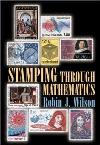'Stamping Through Mathematics'

Stamping Through Mathematics: An Illustrated History of Mathematics Through Stamps
by Robin J. Wilson
Robin J Wilson's book is "not", as he assures the reader in the Preface, "a history of mathematics book in the conventional sense of the word". No indeed. It is, rather, a selective account of aspects of the history of mathematics which have appeared on postage stamps from across the world. Of course, as Wilson himself is at pains to point out, this means that "several important mathematicians or topics are omitted, due to the absence of suitable stamps featuring them". (I felt at this point a sharp desire to know what was meant by a "suitable" stamp, given the inclusion of one or two stamps in the book that seemed to count as "mathematical" only by a generous stretching of normal definitions - for example the St Vincent 40¢ stamp titled "Geoffrey Chaucer, 1342-1400, Father of English Literature", which creeps in by virtue of Chaucer's Treatise on the Astrolabe, "one of the first science books to be written in English".)
This is an enjoyable book to browse through, and of interest not least in illustrating which mathematical topics have been considered "important" and therefore most worthy of depiction on stamps (for example Nicaragua issued a set of stamps illustrating "The 10 mathematical formulas which have changed the face of the world"). It is also interesting to see how stamps have occasionally been used for educational or propaganda purposes, such as a didactic stamp from Ghana published during metrification in 1975 reminding the user that 2 1/2 centimetres equals one inch. The potted biographies of both famous and obscure mathematicians were entertaining, and here proved some of the virtues of the stamp-led approach in allowing a refreshing view of the history of mathematics - President Garfield, for instance, appears on stamps by virtue of his office but was also a little-known mathematician - while the sections on Ancient Chinese or Mayan mathematics cover ground which will be entirely unfamiliar to many people and which deserves to be far better understood.
Overall, though, while this book is engaging and has considerable curiosity value, it will probably be of more interest to philatelists than to those primarily seeking information about the history and development of mathematics. (It will also be a comfort to mathematicians by reminding them that the world at large does sometimes, at least, recognise the importance of their subject, and no doubt many of its readers will be followers of Wilson's "Stamp corner" in the Mathematical Intelligencer.) One quibble that I had was that the style of explanation and assumption of prior mathematical knowledge varied widely from topic to topic, perhaps because due to the chosen layout - each topic is assigned a double-page spread, with text on the left and illustrative stamps on the right - the scope for explanation was sometimes too limited.
Readers who enjoy this book will also be interested to learn (should they not already be aware) that the MSU, "a philatelic study unit whose purpose is to acquire and disseminate knowledge of philatelic materials related to mathematics, mathematicians, and computers", publishes Philamath: a journal of mathematical philately four times a year.
- Book details:
- Stamping Through Mathematics: An Illustrated History of Mathematics Through Stamps
- Robin J. Wilson
- Hardback, 126 pages (2001)
- Springer
- ISBN 0 387 98949 8